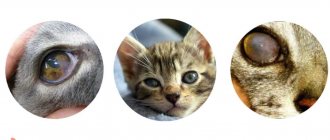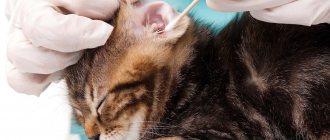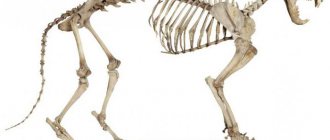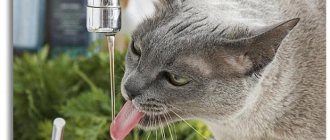Causes of cryptorchidism in cats Diagnostics Treatment Caring for a cat after castration Cryptorchidism in cats is a congenital developmental pathology in which one or both testicles (testes) do not descend into the scrotum, but remain and develop in the abdominal cavity or in the inguinal canals. Typically, an owner notices cryptorchidism in their pet at the age of 2-4 months. However, some owners are unaware of the existence of this problem for quite a long time.
It is believed that cryptorchidism is inherited, so cryptorchid animals are recommended to be castrated and removed from breeding.
In cats, unilateral cryptorchidism most often occurs - that is, when only one testis does not descend into the scrotum, the second one develops normally. Such cats are capable of reproduction. Less common is bilateral cryptorchidism, the undescended state of both testes; with this pathology, the cat most often remains sterile, that is, incapable of reproduction - this is due to the fact that the temperature in the abdominal cavity is higher than necessary to maintain the viability of the seed.
Depending on the type of development, cryptorchidism can be inguinal or abdominal (sometimes also called abdominal). With inguinal cryptorchidism, the testicles are located in the inguinal canal, with abdominal cryptorchidism - in the abdominal cavity.
Is cryptorchidism a disease in cats?
The reason for castration of a cryptorchid cat is not obvious to every owner. In order to understand this issue, it is enough to clarify the essence of this concept and determine the level of its danger.
What is cryptorchidism
Cryptorchidism in cats is a congenital anomaly that does not pose a threat to others. It manifests itself in the incorrect location of the testes (testicles) and excludes other physiological disorders. As a result of this anomaly, one or both organs do not descend into the scrotum, but remain in the inguinal canal or abdominal cavity.
Similar pathologies include monorchism and anorchism, which involve the congenital absence of one or both testes. If a cat has only one testicle, then his body has a low level of testosterone. This feature excludes interest in the opposite sex, so pets with this anomaly cannot participate in breeding.
The attraction to females in cryptorchid cats remains, and the need for castration is explained by the low quality of sperm. It is almost impossible to obtain offspring from such animals. Fortunately for breeders, the probability of giving birth to cryptorchids is no more than 3%.
What is the danger
The main purpose of the scrotum is to preserve the viability of sperm due to the lower temperature. The testes remaining in the peritoneum or inguinal canal are constantly overheated, which leads to the following complications:
- Loss of reproductive function
. If both testicles have not descended in a cat, he is diagnosed with infertility. With a unilateral form of pathology, only the quality of sperm suffers. Fertilization sometimes occurs, but is achieved with great difficulty.
- Hormonal disorders
. Due to the loss of testosterone, the pet develops feminization syndrome. The cat begins to attract other males, and its mammary glands enlarge. Another sign of this disorder is asymmetrical alopecia, accompanied by darkening of the skin in the bald area. Most often, the genitals of the animal become bald.
- Testicular torsion
. The unnatural position is accompanied by acute pain. The animal may suffer from internal bleeding due to damage to the spermatic artery.
- Oncology
. Lack of sperm and elevated temperature stimulate malignant tissue degeneration. Tumors are treatable only at the initial stage, but their timely diagnosis is complicated by a long asymptomatic course.
- Prostate diseases
. Any inflammatory process in the testes is accompanied by a sharp rush of blood to the prostate gland. This is fraught with the formation of stones and tumors.
- Inguinal hernia
. Develops due to non-fusion of the vaginal process of the peritoneum. As a result of its strangulation, the animal may die due to peritonitis.
Castration of a cryptorchid cat helps to avoid all these complications, so veterinarians recommend operating on your pet before alarming symptoms appear.
Cryptorchidism and hormone therapy
A developmental anomaly in a cryptorchid cat occurs as a result of genetic abnormalities, so its treatment mainly uses hormonal drugs. With their help, it is supposed to compensate for the missing testosterone level. This method is justified only if the examination has confirmed its deficiency as the root cause of the pathology.
Hormone therapy is only permissible for adult cats with a fully developed skeletal system and if necessary.
The difficulty of such treatment lies in the temporary effect; very often, after stopping the supply of testosterone artificially, the body returns to its original state. In addition, tests to determine hormonal levels are quite expensive, and the hormonal medications themselves cost a lot. Therefore, there is no point in carrying out such therapy, since it is almost impossible to obtain healthy offspring from such a cat and he is unsuitable for breeding.
What does a cryptorchid cat look like?
First of all, the anomaly affects the appearance of the scrotum. It loses its elasticity and wrinkles. Over time, changes appear in the proportions of the animal. The skeleton becomes more elegant and fragile, which is typical for females.
The main method of diagnosis is palpation, so most often the pathology is confirmed only during an examination by a veterinarian. When independently identifying the problem, it is recommended to take into account not only external signs, but also some behavioral changes.
Rules of care in the postoperative period
For the operation, general anesthesia is used, so after castration it is recommended to spend the first hour in the clinic. Thanks to this, specialists will be able to quickly help your pet if complications arise. If the cat's breathing and heartbeat do not cause concern, he can be taken home.
After anesthesia, the animal's heat exchange will be disrupted. In the cold season, he needs to be wrapped in diapers or a blanket; in hot weather, overheating should be avoided. It is better to transport your pet in a personal car or taxi. It is not recommended to travel using public transport, because... The cat is already stressed.
A new environment and a large number of people around can frighten him. If the pet has not recovered from anesthesia, you need to moisten its eyes: close and open the eyelids. Otherwise, the mucous membranes may dry out.
After returning home, you need to create a cozy corner for the cat. You can put pillows or cover the floor with soft bedding. Drafts should be avoided. The animal must be kept away from batteries. If additional heating is needed, you can wrap warm water bottles with towels and place them nearby.
It is advisable to stay close to your pet, because... his consciousness and coordination of movements will be impaired at first. The cat may react aggressively towards you. If this happens, move away but keep an eye on him.
Your pet should be isolated from other animals. Due to the foreign smell, the latter can hiss and even attack or help him remove the blanket.
You can give water to your cat only 2-3 hours after the operation, when the pet comes to its senses. Otherwise, he may experience nausea. Do not leave a bowl of water nearby, as the animal may choke. Food is given after 6-8 hours. Solid particles can injure the operated area, so products with a rough texture should be avoided.
Dry food should be soaked. In order not to aggravate stress, it is better to give your cat his usual food. The animal is switched to new food after 1-2 weeks.
The tray is left as close to the cat as possible so that in the first days after the operation he does not have to move much. Perhaps the pet will miss. There is no need to scold him for this. It is advisable to remove the filler from the tray for 5-7 days or install a mesh. Coarse fibers can injure the animal.
To speed up healing, it is recommended to treat the scar. This is done 2 times a day with peroxide and brilliant green. Veterinarians often prescribe the use of antibiotics to prevent wound infection.
Since cryptorchids undergo a more complex operation and involve tissue of the groin or peritoneum, cats need to wear blankets. It is advisable to observe the animal before removing the sutures. Some pets remove their blankets or lick the fabric and injure the wound with their rough tongue.
This may lead to bleeding or infection. If your pet shows increased interest in the injured area, you can put an Elizabethan collar on it.
Types of pathology
The most common type of cryptorchidism in cats is unilateral, involving the correct descent of the left or right testis. If the problem arises from both organs, then the pathology is called bilateral.
In addition to classification according to the number of “hidden” testicles, there is a division according to their location.
Abdominal
This type is not amenable to visual and manual diagnosis, since the testis is hidden behind the fatty layer of the abdominal cavity and is often underdeveloped. You can notice it among other internal organs only on an ultrasound.
Inguinal
The “hidden” testicle is located in the fat layer of the groin area. Due to its close location to the skin, it is easy to see and feel. The anomaly, resembling a small ball just above the scrotum, is especially noticeable in massive short-haired pets. Usually, owners mistake this subcutaneous tumor for cancer, so they immediately take their pet to a veterinary clinic for examination.
False
In this case, there is free movement of organs from the scrotum to the peritoneum and back. This happens due to stress and hypothermia. After eliminating the pathological factor, the organ returns to its proper place.
Secondary
A false-type complication that occurs due to the presence of adhesions in the peritoneum or excess accumulation of fat. As a result of these factors, the testes cannot return to their place, continuing to move freely along the inguinal canal and abdominal region.
Answers to popular questions:
- How to independently determine whether a cat is cryptorchid?
It is possible to verify that a cat has an anomaly such as cryptorchidism, or its absence, only when he is at least six months old. It is by this time that his testes should normally descend to their designated place in the scrotum. To do this, you need to carefully examine the cat or examine it using palpation. In cases where there are doubts about the presence of two testicles, it is better to contact a veterinary clinic. The difficulty in diagnosing lies in the type of cryptorchidism; if in the inguinal form it is not difficult to determine the presence of abnormalities, then the abdominal type is sometimes difficult to identify even with the help of ultrasound.
- During castration, is it possible to remove only one testicle and leave the one that has not descended into the scrotum?
In this case, it is usually recommended to carry out complete castration, which will prevent such pathology from appearing in his possible offspring. A castrated animal will get rid of the urge to reproduce, will not harass itself and its owners with screams and mark its territory, and will also become calmer and non-aggressive. He himself will not feel deprived of anything and will remain a plush pet for a long time.
Video: 1 testicle has not descended into the scrotum, what should I do, is castration necessary?
Causes of cryptorchidism in cats
In the absence of pathology, the testes descend into the scrotum before the kitten reaches 6 months. If this does not happen, then the reason lies in:
- Hormonal disorders
. Due to insufficient testosterone, the force responsible for prolapse is reduced. As a result, the organ “freezes” somewhere along the way, without reaching the final goal.
- Infectious diseases of the mother or postpartum injuries
. There may also be danger in potent drugs used during pregnancy. Because of this, it is important to treat the animal only under the supervision of a veterinarian.
- Disturbances in the development of internal organs
. Natural descent is hindered by adhesions, a short spermatic cord, excess connective tissue and a too small opening in the inguinal canal.
- Testicle size
. If the norm is exceeded, passage of the testicle through the existing opening becomes impossible.
Of all the above reasons, only diseases in a pregnant cat can be prevented. The remaining cases do not depend on the conditions of detention and care, so the owner can only find out about them from a veterinarian.
Surgery for inguinal cryptorchidism
When performing an operation in the case of inguinal cryptorchidism, the hair is removed from the site of the proposed intervention, then an incision is made over the undescended testicle and it is completely removed, after which the spermatic cord is ligated or cauterized using a coagulator. The final step is suturing.
During the postoperative period, you need to put a special collar on the cat, which will prevent him from licking the stitches and will not allow pathogenic bacteria to be introduced there. Until the wound is completely healed, you need to treat the stitches with one of the antiseptics.
Diagnosis of the problem
The age of the animal is important for successful diagnosis. Due to the peculiarities of the development of the gonads, you have to wait until the pet reaches six months. This is often taken advantage of by scammers who keep silent about the presence of cryptorchidism in the cats they sell.
At the kitten's
The only way to check a kitten is to meet its father. When purchasing, be sure to request documents for both parents. If possible, get to know them in person, since in adult animals the problem is often visually noticeable.
In an adult animal
Diagnosis in adulthood depends on the type of pathology. In most cases, a visual inspection and palpation is sufficient for the veterinarian. If this is not enough, then ultrasound of the peritoneum and groin area is used. In rare cases, the abdominal type is discovered only during surgery.
Is it possible to independently detect cryptorchidism in a cat?
The inguinal type of pathology lends itself well to self-diagnosis. In addition to external changes, it is noted:
- Increased fascination with females, regardless of the presence of estrus. On the part of cats, a reverse reaction is observed, often accompanied by open aggression.
- Prolonged lack of fertilization, regardless of the number of matings performed. Only 40% manage to have offspring. In this case, the anomaly passes on to the kittens.
- Unusual posture when urinating. The cat urinates like a dog, raising its hind leg.
Particular attention should be paid to pain. This symptom appears very rarely and only during complications. If palpation of the groin or peritoneum causes severe pain to your pet, contact a veterinary clinic immediately. This reaction occurs when nerve canals are compressed, which is fraught with death and decomposition of the organ.
Surgery for abdominal cryptorchidism
This type of operation is in many ways similar to sterilization, as it involves an incision along the linea alba of the abdomen. After this, the testicle is pulled out and cut off, after which the opening of the spermatic cord is closed and sutures are applied. Often, an animal operated in this way is left in a veterinary hospital for several days to monitor its condition.
After surgery, the cat may be prescribed a course of vitamin therapy, as well as hemostatic and anti-inflammatory drugs. Only careful adherence to all the veterinarian’s recommendations will allow him to quickly recover from the shock, recover and get back on his feet.
It should be noted that a cat with cryptorchidism does not feel any worse and lives a full life. The possibility of the testis degenerating into a malignant neoplasm, although present, is still small.
Treatment options
Cryptorchidism in cats is treated with surgery or hormonal therapy. The first method is considered more effective, since, in addition to suppressing reproductive function, it eliminates the risk of developing a malignant tumor.
Hormone therapy
If the cause of the abnormalities is a lack of testosterone, then the pathology is treated with hormonal drugs. This therapy is contraindicated in pets under 1 year of age, as it can cause growth retardation and deviations in the development of the skeletal system.
The rare use of drug treatment is explained by its high cost and low effectiveness. When testosterone is withdrawn, the anomaly often returns. If everything went well, the animal will still not be able to participate in breeding. This is why cryptorchid cats usually undergo surgery to remove their reproductive organs.
Operation – specific castration
Surgery is performed at 7-9 months. Instead of sterilization, cryptorchid cats are castrated. Owners often confuse these concepts, dividing them by gender. In reality, the difference between these operations lies in the method of suppressing reproductive function. A sterilized pet loses the ability to inseminate while maintaining attraction, and a castrated pet loses both. The last option is most justified in the prevention of cancer.
The operation is performed under general anesthesia for 1.5 hours. Through the incision, the surgeon pulls out and cuts off the testicles, ligating or cauterizing the spermatic cord. In the case of the abdominal type of pathology, the vas deferens is first cut off, and the testes are pulled out through the abdominal cavity. At the end of the procedure, stitches are placed at the incision site.
Is it possible to remove just one testicle?
This option is possible, but ineffective. Left with one testicle, the cat will continue to leave scent marks, maintaining attraction and aggression. For this reason, it is safer and smarter to agree to a complete deletion.
Inguinal cryptorchidism
Cryptorchia is not a disease, it is just a pathological deviation in the development of the animal’s genital organs, in which the location of the testicles is disrupted in the form of their failure to descend to their intended place, namely the scrotum. If such a testicle or both of them remain in the groin area, then this case is inguinal cryptorchidism. During the examination, a hidden and undescended testis is located in the groin area, and it is often surrounded by a fatty layer and can be easily identified by palpation.
Rehabilitation period
The recovery period after abdominal surgery is longer than after regular castration. Before the suture heals, try to pay a lot of attention to your pet, protecting it from injury and infection.
How is recovery going?
After anesthesia, slight lethargy and loss of coordination are acceptable. Provide your pet with a comfortable place on the floor and stop any attempts to climb higher. Due to impaired heat exchange, wrap it in a blanket, but keep it away from the radiator. Such a heat source can trigger the development of inflammation.
A hunger strike on the first day is natural, but dehydration should be avoided. If the animal refuses to drink on its own, then it needs to be given a drink after 2-3 hours from a pipette or syringe. In addition to the oral cavity, you will also have to moisten your eyes. The introduction of an anesthetic often disrupts natural blinking, which can lead to drying out of the mucous membranes.
Don’t be alarmed that a cat who has woken up from anesthesia walks around on its own. Place absorbent diapers under his sleeping area and change them regularly after getting wet. Be sure to eliminate drafts and keep the animal away from children and other pets. The operated pet will need not only warmth, but also a calm environment.
Pet care
The next day the animal can be fed. In the first week, it is better to use wet canned food or soaked dry food. Natural foods include light meat broths and slimy porridges.
To protect the seam from damage, a blanket is put on the cat. Additionally, a protective collar may be required to prevent the wound from licking. Treatment of the seam is permissible only as prescribed by a veterinarian, since ointments inhibit the process of tissue regeneration.
Possibility of complications
You will have to contact a veterinarian in case of prolonged refusal to eat (more than 1-2 days) and prolonged constipation (more than 2-3 days). Also a cause for concern is any change in the wound area: redness, severe swelling, suppuration, bleeding. If all recommendations are followed, including a two-week home quarantine, the likelihood of developing these complications is close to zero.
Unlike the standard disease, cryptorchidism is not dangerous in the short term. You shouldn’t rush to the vet headlong at the first sign of an abnormality. But it is also impossible to remain inactive, expecting possible complications.
The most reliable solution to this problem is castration. Despite the loss of value in breeding work, the operated cat retains the ability to participate in exhibitions and acquires a more friendly character. Approach the situation adequately, preventing the inheritance of the anomaly.
The article is for informational purposes only. Contact your veterinarian!
Rehabilitation after surgery
When taking an animal home after surgery, the owner should be aware of some rules that will allow rehabilitation to be carried out quickly and with minimal discomfort for the cat.
Firstly, you need to prepare in advance the place where the cat will be for the first hours after the operation. The animal is protected from drafts and excessively hot radiators. Fine. If you manage to restrict your pet’s movements using a carrier or cage, the cat will feel insecure when recovering from anesthesia and may get injured.
During the first hours after recovery from anesthesia, the cat should be monitored or placed in a cage.
You need to carefully monitor your pet's condition, reporting any negative changes to your doctor. If the cat refuses to eat for the first day or two, it's not a big deal. If the animal continues to ignore food, behaves lethargically and is not interested in anything, this is a reason to urgently visit a doctor.
Another common side effect of abdominal surgery in cats is the absence of bowel movements. To help your pet, you can give him a teaspoon of Vaseline oil, which acts as a mild laxative. But, it is worth using it on the third or fourth day if the cat was still unable to defecate on its own.
The oil can be mixed with food or administered into the cat's mouth using a rubber bulb.
You must also carefully follow the individual recommendations of your veterinarian. The cat may be prescribed hemostatic drugs, anti-inflammatory or antibiotics, and vitamins.
One or two: how many testicles to remove?
Often, with unilateral cryptorchidism, the owners insist on leaving one fully protruded testicle in the scrotum. But veterinary experts do not advise leaving “half of a man’s pride” to cryptorchid cats. The following arguments are put forward in opposition to the owners:
- cryptorchids are castrated in any case, such cats are removed from breeding clearly as carriers of the defective gene;
- cryptorchids are aggressive, what causes this is not entirely clear;
- breeders get rid of the opportunity to hear spring chants and wash away odorous marks.
It is recommended to carry out castration only in a veterinary clinic. If with simple sterilization access to the testes in the scrotum is easy, then if the testicle is in the abdominal cavity, it is impossible to visualize it without ultrasound or endoscopic methods. The course of the operation depends on where exactly the testis “hid”, how long the vas deferens, etc.
But in any case, the surgical intervention itself was worked out to the smallest detail, and no complications were observed after it. The cat continues to live the life of an ordinary castrated individual.
Important! The only condition that the veterinarians of the RosVet VC ask you to strictly observe is a timely (immediate) visit to the clinic. A testis that does not enter the scrotum becomes a source of direct danger - tumors develop against its background, often malignant with the risk of metastasis to other organs. And the cryptorchid cat, which, theoretically, can live a long life, dies from oncology due to the fault of its owners.
If you suspect that your pet’s testicles have not completely come out, do not hesitate, contact the RosVet VC for advice. You can make an appointment by phone +, 24 hours a day. If it is impossible to personally visit the clinic for an examination, you can call a veterinarian at home.
Is it possible to detect a disease in a kitten?
It is impossible to accurately identify the disease in small kittens. It is believed that normally the testicles should descend into the scrotum at 2 weeks. However, in practice, even at 2 months, not all kittens have their testes in their place. Also, the testicles may first descend and then rise. This can occur with false cryptorchidism or too short spermatic cords.
The diagnosis is finally made only at 6 months; until this point, the kitten’s condition may change.
The only way to protect yourself from unscrupulous breeders is to buy animals from reputable nurseries and check the parents of the kittens. It is advisable to examine the cat and make sure that the testes are complete. If you are purchasing animals for breeding, it is better to conclude an agreement.











